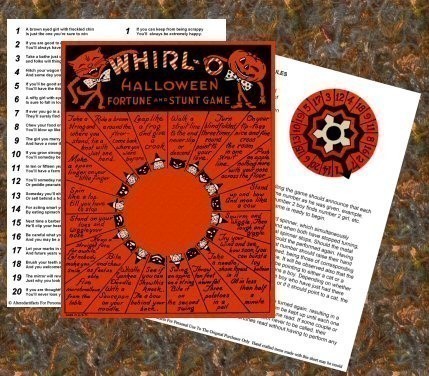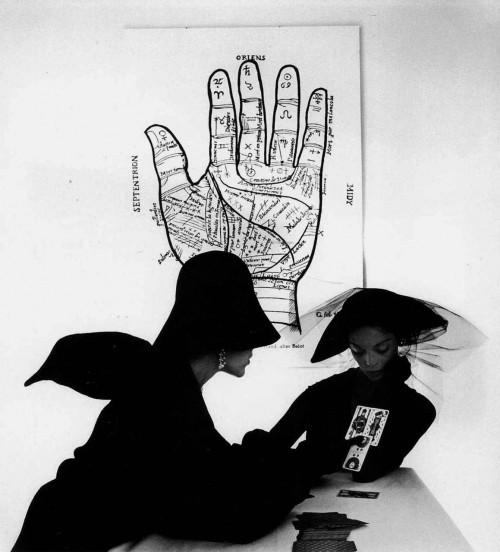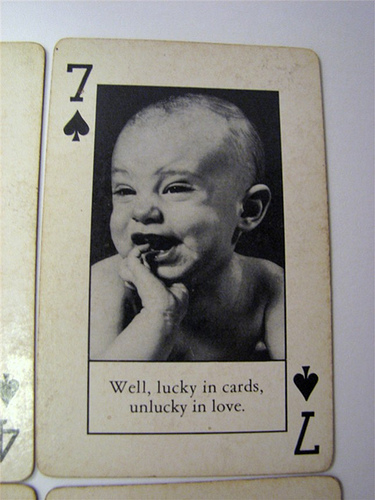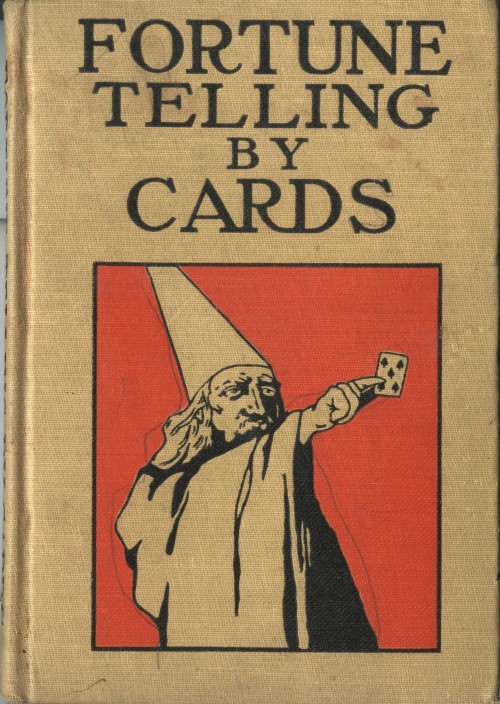Get a digital copy of this vintage Whirl-O Halloween Fortune and Stunt Game Wheel for your Halloween party! From AlteredArtifacts.
Tag: fortune telling
Fashion Forecasting With Tarot Cards, Part Two
The Tarot Reader, photographed by Irving Penn and published in the October 1949 issue of Vogue, predates our earlier fashion forecasting post. The models are Bridget Tichenor and Jean Patchett.
Bewitching & Beguiling
Exposition solo de Hyuna Ji Nature and Organisation à la galerie Kwanhoon; via.
Fashion Forecasting With Tarot Cards (In 1953)
A fashion spread in Harper’s Bazaar, August 1953, featuring over-sized tarot cards. Photos by Louise Dahl-Wolfe.
Retro Zolar Fortune Telling Materials
An ad for Zolar fortune telling cards and Ouji Genii Board found in Rance Romance & Adventures, May 1971.
Aunt Lydia’s Baby Gender Prediction Method
 I found the following gem in the 1977 J. Gruber’s Hagers-Town, Town and Country Almanack, along with the usually almanac-ery, household tips, and a few grand ads (that I’ll be showing off later). It’s a prediction method for pregnant women to discover the gender of their baby.
I found the following gem in the 1977 J. Gruber’s Hagers-Town, Town and Country Almanack, along with the usually almanac-ery, household tips, and a few grand ads (that I’ll be showing off later). It’s a prediction method for pregnant women to discover the gender of their baby.
In case the name Aunt Lydia sounds familiar, this is not the Aunt Lydia from The Handmaid’s Tale who was responsible for teaching the enslaved women called “handmaids.” (The movie adaptation is where I first fell in love with Natasha Richardson, may she rest in peace.) This Aunt Lydia was Miss Lydia Cline, “a retired practical nurse who lived in and around Hagerstown,” whose method of prediction was heralded to have “an accuracy of over 80%!”
Even though Aunt Lydia had passed away in 1973, the almanac’s 1977 proclamation was to ensure readers that they could still accurately predict the gender of unborn children — under the following conditions:
Here’s an example of just how Aunt Lydia’s formula works. Say, for instance, your last child was born in 1973 on the first day of January; the birth sign under which the child was born would be Sagittarius, the Archer. As the sign did not change but remained the same for the following day, the 2nd, that year, there would be no change in the sex of your next child. If, however, the child had been born January second, it would still have been born under the sign of Sagittarius, but because the following day, the 3rd, the sign changed to Capricorn, the Goat, there would be a change in the sex of the next child.
(One assumes you’ll need the astrological information as provided in past issues of this almanc; for those of child bearing years, who want more recent issues, check the official Hagerstown Town and Country Almanack website. The article also notes that the simple formula does not work with a first child, nor for induced or Caesarian delivered births.)
If only author Margaret Atwood had known of this Aunt Lydia and her prophetic equation… With such knowledge, the gender of babies could have been more than divined, but planned.
It may not have prevented Gilead from increasing the number of gender-crimes (for that’s how, you’ll remember, women were forced into becoming handmaids) or otherwise improved the lot of women, but it would have raised other interesting avenues of thought.
However, Hagerstown’s Aunt Lydia and her formula were incorrect regarding my second child. Not sure if that signals failure on the part of Aunt Lydia, a missing part of the prediction formula retained to secrecy, or if, per the usual, I am just relegated to the position of minority.
Taking Off Those Kid Gloves About The Collectors Convention
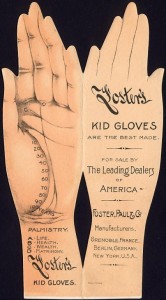 Hey, that conference I’m presenting at, the first annual Bookmark Collectors Virtual Convention, has been written up in the Seattle Post-Intelligencer. Which reminded me that I had not mentioned the event here, pestering you to attend. So, here it is, “Will you please attend the convention?”
Hey, that conference I’m presenting at, the first annual Bookmark Collectors Virtual Convention, has been written up in the Seattle Post-Intelligencer. Which reminded me that I had not mentioned the event here, pestering you to attend. So, here it is, “Will you please attend the convention?”
I think there’s still some free commemorative bookmarks available, so check that out before you register.
And, in case you missed it, here’s my story about incidentally collecting bookmarks: When I Was A Child, I Bookmarked As A Child (Or, Seeking The Perfect Bookmark).
Image Credits: This bookmark advertising Paul Foster & Co. kid gloves also features palmistry; it was submitted to the convention’s gallery by Laine Farley.
In The Cards: Ace of Hearts
It’s been ages since I’ve done one of these! (I guess that’s what happens when stuff gets buried on your desk!) Anyway, here’s another card described in rhyme from Fortune-Telling by Cards, by Professor P. R. S. Foli; this one the fortune for the one who draws the Ace of Hearts:
He that draws the ace of hearts
Shall surely be a man of parts;
And she that draws it, I profess,
Will have the gift of idleness.
Card from a vintage deck at eBay.
Police Woman: The Long Octopus Arms Twarting Female Police Detectives
 Most of us tend to think of Angie Dickinson when we think of police women — and it’s not just because she was Sgt. Suzanne “Pepper” Anderson on Police Woman in 1974.
Most of us tend to think of Angie Dickinson when we think of police women — and it’s not just because she was Sgt. Suzanne “Pepper” Anderson on Police Woman in 1974.
Most of us tend to think of the 60’s & 70’s when those women’s libbers pushed and sued for the opportunity to be equals (including police officers) and Angie baby was in full mod swing then, so naturally we “see” her as the face (and bod) of the mod we’ve-come-a-long-way-baby policewoman. And the plethora of Police Woman dolls & toys — like this ridiculous “Sabotage Under The Sea” set with octopus — helped solidify this image for a lot of us.
But in truth, there not only were female cops before then, but they were the result of what we’d now call “unlikely feminists” — and some bad male behavior. These battles would be more dangerous than tangling with an octopus.
You may have heard of Isabella Goodwin, the first US woman detective appointed in New York City on March 1, 1912 (it’s the sort of “fun historical fact” people like to blog about, say, on March 1st). But few take the time to give you some real information about her — or at least some cultural context. But you know I’m all about the context, right?
There’s little information available on the web about Isabella Goodwin (save for the fact one-liner), but there is a story & a setting alright.
The story begins in the mid 1800’s when female prisoners were housed with male prisoners and so male officers, their wives, widows of policemen (called “bedmakers,” these women were paid out of the policemen’s own pockets), or “the maid at the police station” performed searches on female prisoners. Such mingling of the sexes shocked the general public — mainly because of the high number of poor men and women who came to New York City often found themselves forced to find shelter at station houses (these people were called “casuals”). According to the NYPD, “in 1887, at various times, up to 42,000 of these homeless women spent at least one night in a station house.” However, things were about to change.
The Women’s Prison Association of New York and the American Female Christian Temperance Union petitioned the Board of Estimate and Apportionment for the appointment of police matrons, and for the creation of separate prison cells for men and women. If it sounds odd to you that Christian women of the 1800’s would be involved in a feminist push for equal career opportunities, you misunderstand. The push was not for careers for women, but for the protection of women who could be victimized by men. And you must remember that once upon a time, Christians saw their role in society as to help the less fortunate, including through social reform, as opposed to the current day philosophy of “”convert them or judge them & leave them to rot.”
Pressured by groups seeking social reforms, the New York State Legislature passed a law requiring that female doctors treat female patients in mental institutions & that every precinct station house has Police Matrons to tend to female arrestees. This legislation was passed in 1888. But the New York City Board of Police Commissioners does not make any Matron appointments until 1891 — after Governor David B. Hill signed a bill that mandated the hiring of Police Matrons and the establishment of separate cells for men and women under arrest. This was a direct result of a police officer being found guilty the attempted assault of a fifteen-year-old girl at a station house and sentenced to prison in 1890.
Months later, the first civil service test was held for the title of Police Matron — with applicants being required to have letters of recommendation from at least twenty women “of good standing.”
In an attempt at humor, I suppose, Jay Maeder sums up the “new” police matrons with “thus creating the jail-matron system that remained a sinecure for many a stern, stout Irishwoman well into the 20th century.”
:sigh:
Maeder’s stereotype isn’t the worst, or even the first. Gilder Lehrman Institute of American History notes:
Of course the matrons were not installed without criticism, which by the way ranged from the prediction that women would become totally incapacitated at the sighting of a mere rodent to criticism that men wouldn’t stand a chance because women would completely take over, dominating the station house and their fellow male employees.
Police Matrons worked long hours, receiving only one day off per month, and just one week’s vacation per year. In 1896, there is one Matron per shift (one day, one night) per station house. Their duties increase too. Matrons are now assigned to search subjects; process, escort and supervise inmates; and to care for lost children. As of 1899, they were paid $1,000 per year as of 1899, and they would not receive a pay increase until 1918.
It is in 1896 that police widow Isabella Goodwin (noted as having four children) is hired as a Police Matron and begins her police career, which will culminate in making First Grade Detective in March of 1912, and being appointed second in command of the first Women’s Police Precinct in April that same year.
Goodwin’s appointment to detective came about through the Police Chief bypassing Civil Service requirements that discriminated against women — presumably in large part due to pressure from the public and lots of press regarding her role in “bringing to justice of the taxicab bandits,” as evidenced in Goodwin’s interview in The New York Times, March 3, 1912 (below).
You really should read it; where else can you read a real news story which includes characters called Swede Annie and Eddie The Boob?
The old newspaper article also includes Goodwin’s story of a bust of a (male) fortune teller. The problem of $2 readings were apparently quite prevalent, for The New York Supplement details of Goodwin’s testimony & the judge’s affirmation of the conviction of fake fortune teller Maude Malcolm on Janurary 18, 1915 (beginning on page 919).
Goodwin, naturally, ends the interview with a, “Despite my peculiar work I try not to neglect my home. A woman’s first duty is to her family, and I have tried always to remember that.” To which the author is only too happy to pander, prove (with assertions from Isabella’s children & the author’s own eyes) & compliment.
But if this seems, well, less satisfactory than the loud “long way baby” route of the mod 60’s women’s lib ladies, consider the following…
Such public adoration may have been new to Goodwin and to female policewomen at the time, but Jay Maeder notes it wouldn’t stay that way:
Matrons did women pretty much exclusively until 1912, when one Isabella Goodwin, theretofore detailed to the wayward-lass wing of the Mercer St. station, was assigned to take a position as a domestic in a household full of suspected bank robbers. Goodwin, swiftly getting the goods on this bunch, then became New York’s first female detective first grade. Subsequently, more and more women began to get pulled into crime-busting duties, and a full-fledged Bureau of Policewomen was established in 1926.
The city’s lady cops, many of them nurses and lawyers and social workers and other such college-educated professionals, were celebrated public figures all through the 1930s and ’40s and ’50s, always good press copy as they went often quite dangerously undercover to lure sexual predators and smash abortion rings and whatnot.
Isabella Goodwin may never have had a doll or octopus made in her honor; but then again, she was probably never called “a bitch of a detective” in some sort of twisted praise. Angie Dickinson, on the other hand, only played a detective on TV and got the doll, the octopus, the pinup poses in men’s magazines, and had her then-husband, Burt Bacharach, “compliment” her by saying, “”If she’s down a notch from me in the public eye these days, well, she should be up a notch—she’s a bitch of an actress.”
So I ask you, who was the more respected woman? Who should we think of when we think of “police woman?”
And why hasn’t someone made a collectible Isabella Goodwin doll?
Maybe instead of an octopus accessory, it can have a fake fortune teller accessory kit.
Forget About Tea-Leaf-Reading Gypsies
Find your own romantic future with Esther Derkx Improved Crockery Teacups featuring retro beefcake and flirty gymnasts posing provocatively in your teacup.
In The Cards: Seven Of Spades
The Seven of Spades described in rhyme from Fortune-Telling by Cards, by Professor P. R. S. Foli:
Now as the seven comes to hand,
It does entitle you to land;
But maids with this shall wed with those
That have no money, friends, or clothes.
Lucky in cards, unlucky in love card via Flickr.
In The Cards: Three Of Diamonds
Another card described in rhyme from Fortune-Telling by Cards, by Professor P. R. S. Foli: the Three of Diamonds:
You that have drawn the number three
Great honour will your fortune be;
But if a female draw the same,
She must beware of fickle shame.
Card from Flickr.
In The Cards: Queen Of Hearts
Another card described in rhyme from Fortune-Telling by Cards, by Professor P. R. S. Foli; this time the Queen Of Hearts:
Now by this card it is well known
Thou shalt enjoy still all thine own;
But women, if they draw the same,
Shall sure enjoy a happy name.
The image is from Pinup Playing Card Cigarette ID Case/Business Card Holder from sweetheartsinner at Etsy.
In The Cards: Ace Of Diamonds
As promised, the first rhyming fortune-telling verse.
The Ace of Diamonds:
Since that this ace is now your lot,
You will wed one that’s fierce and hot;
But if a woman does draw it,
She will wed one with wealth and wit.
Now just what have we learned? That the Ace of Diamonds is a good card, yes; but also that women are valued for their passionate lusty ways while men are valued for their wealth — and wit. Now feel free to discuss.
Vintage Fortune-Telling: Love & Romance In The Cards?
I’ve got this old book, Fortune-Telling by Cards, by Professor P. R. S. Foli (aka Sir Cyril Arthur Pearson). My copy is an old hardcover edition published by R. F. Fenno & Company.
One of the chapters has silly little rhyming divination poems for each card in a regular deck of cards and I thought it would be a hoot to post these as a semi-regular feature here, starting with the overview at the beginning of the chapter:
There are those to whom the more elaborate forms of fortune-telling by cards may seem a trifle wearisome, or possibly too intricate to be followed without a somewhat exhausting effort of attention.The method which we give in this chapter has the advantage of being at once simple, diverting, and varied.
As the rhyming significations concern both sexes, a great deal of fun can be provided where there is a party of young people, and who can tell whether the long arm of coincidence may not use this old-time practice to bring some loving pair together?
Take a new pack of cards, or at any rate one in which there are no tell-tale marks on the reverse sides, and spread them face downwards upon the table. Before any one draws a card, he or she is requested to close the eyes, place the right hand on the heart, and say, “Honi soit qui mal y pense.” The card must then be drawn with the left hand, and its meaning will be read by the one who holds the key contained in the verses which we now give.
I just know that you’re just dying to begin play — but be patient, my little love bunnies! I’m only giving a tip at a time. The first card rhyme will be posted tomorrow, but after that, you won’t know just when…
And yes, this is a shameless way to get you to keep visiting.
